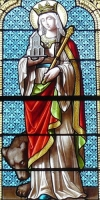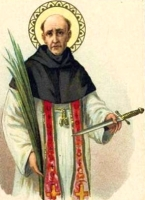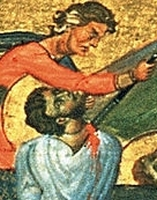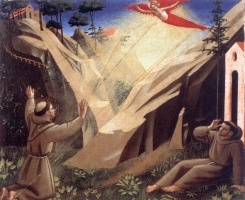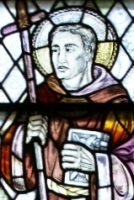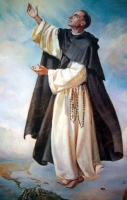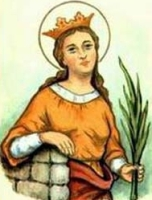St. Methodius of Olympus
Feastday: September 18
Death: 311
Bishop and martyr, famous for his writings. St. Jerome wrote of his martyrdom at Chalcis, in modern Greece. Methodius was the bishop of Olympus, Lycia, in Asia Minor. He then ruled Tyre, Lebanon, or possibly Patara, in Lycia, and was the author of the treatise On the Resurrection and the Symposium .
Papyrus fragment of the Symposium, oratio 8, dated 5th or 6th century, the earliest known manuscript of a work by Methodius (Montserrat Abbey library, P.Monts. Roca 4.57)[2]
Saint Methodius of Olympus (Greek: Μεθόδιος)[3][4] (died c. 311) was a Christian bishop, ecclesiastical author and martyr today regarded as a Church Father. He is commemorated on June 20.[5]
Life
Few reports have survived on the life of this first systematic opponent of Origen; even these short accounts present many difficulties. Eusebius does not mention him in his Church History, probably because he opposed various theories of Origen, thus Saint Jerome provides the earliest accounts of him.[6] According to him, Methodius was Bishop of Olympos in Lycia and afterwards Bishop of Tyre. No later Greek author knows anything of his being Bishop of Tyre; and according to Eusebius,[7] Tyrannio was Bishop of Tyre during the persecutions of Diocletian and died a martyr; after the persecution Paulinus was elected bishop of the city. Later sources make him bishop not of Olympos but of Patara, also in Lycia. It has been conjecture that he could have held both sees simultaneously, but this is unlikely.[8]
Jerome further states that Methodius suffered martyrdom at the end of the last persecution, i.e., under Maximinus Daia (311). Although he then adds, "that some assert", that this may have happened under Decius and Valerian at Chalcis, this statement (ut alii affirmant), adduced even by him as uncertain, is unlikely. Various attempts have been made to clear up the error concerning the mention of Tyre as a subsequent bishopric of Methodius; it is possible that he was transported to Tyre during the persecution and died there.
St. John Macias
புனிதர்ஜான் மசியாஸ்
டோமினிக்கன் துறவி/ பொதுநிலை சகோதரர்:
(Dominican Friar and Lay Brother)
பிறப்பு: மார்ச் 2, 1585
ரிபேரா டெல் ஃப்ரெஸ்னோ, எக்ஸ்ட்ரீமடுரா, ஸ்பெயின்
(Ribera del Fresno, Extremadura, Spain)
இறப்பு: செப்டம்பர் 16, 1645
லிமா, பெரு, புதிய ஸ்பெயின்
(Lima, Viceroyalty of Peru, New Spain)
ஏற்கும் சமயம்:
கத்தோலிக்க திருச்சபை
(Catholic Church)
முக்திபேறு பட்டம்: கி.பி. 1837
திருத்தந்தை பதினாறாம் கிரகோரி
(Pope Gregory XVI)
புனிதர் பட்டம்: கி.பி. 1975
திருத்தந்தை ஆறாம் பவுல்
(Pope Paul VI)
முக்கிய திருத்தலம்:
ஜெபமாலை அன்னை பேராலயம், லிமா, பெரு
(Basilica of Our Lady of the Rosary, Lima, Peru)
நினைவுத் திருவிழா: செப்டம்பர் 18
புனிதர் ஜான் மசியாஸ், 1620ம் ஆண்டு, பெரு (Peru) நாட்டில் சுவிசேஷ பணியாற்றிய ஒரு ஸ்பேனிஷ் டோமினிக்கன் துறவி (Spanish-born Dominican Friar) ஆவார். இவரது பிரதான உருவப்படம், லிமா (Lima) நகரிலுள்ள செபமாலை அன்னை பேராலய திருப்பலி பீடத்தில் அமைக்கப்பட்டுள்ளது. 1970ம் ஆண்டு, பெரு (Peru) நாட்டின் லிமா (Lima) நகரிலுள்ள “சேன் லூயிஸ்” (San Luis) எனுமிடத்தில், இவரை கௌரவிக்கும் விதமாக, இவர் பெயரில் ஒரு ஆலயம் கட்டப்பட்டுள்ளது.
“ஜுவான் டி ஆர்க்கஸ் ஒய் சான்செஸ்” (Juan de Arcas y Sánchez) எனும் இயற்பெயர் கொண்ட இவர், கி.பி. 1585ம் ஆண்டு, மார்ச் மாதம், 2ம் தேதியன்று பிறந்தார். இவரது பெற்றோரான “பெட்ரோ டி அர்காஸ்” (Pedro de Arcas) மற்றும் “ஜுவானா சேன்செஸ்” (Juana Sánchez) இருவரும் ஏழை விவசாயிகளாவர். நாலு வயதான இவரும் இவரது சகோதரி மேரியும் சிறுவர்களாக இருக்கையிலேயே இவரது பெற்றோர் மரித்துப் போயினர். சிறுவர்கள் இருவரையும் இவர்களது தாய்மாமன் வளர்த்தார். அவரது கடைசி பெயர் “மசியாஸ்” (Macias) ஆகும். சிறுவர்கள் இருவருமே தங்களது கடைசி பெயராக இப்பெயரையே ஏற்றனர். இவர்களது தாய்மாமன், ஜுவானை கால்நடைகள் மேய்க்க பயிற்றுவித்தார். ஜுவான் செபமாலை செபிப்பதிலேயே நீண்ட மணிநேரங்களை செலவிட்டார்.
ஜுவான், ஒருமுறை தமக்கு பதினாறு வயதாகையில், பக்கத்து கிராமமொன்றில் திருப்பலி காண போயிருக்கையில், டோமினிக்கன் துறவி ஒருவரை சந்திக்க நேர்ந்தது. தாமும் ஒரு டோமினிக்கன் ஆவதற்கான சாத்தியக்கூறுகளை கருத்தில்கொள்ள தொடங்கினார். தமது வாழ்க்கையில் கடவுளுடைய சித்தத்தை இவர் தேட ஆரம்பித்தபோது, இவரது பாதுகாவல் புனிதரான தூய யோவான் அப்போஸ்தலரும், அன்னை கன்னி மரியாளும் அடிக்கடி இவருக்கு காட்சியளித்ததாக கூறப்படுகிறது.
25 வயதான மசியாஸ், பின்னர் ஒரு பணக்கார தொழிலதிபருடன் பணிபுரியத் தொடங்கினார். அவர் இவரை தென் அமெரிக்காவிற்கு பயணிக்க வாய்ப்பளித்தார். “கொலம்பியாவின்” (Colombia) “கார்டகெனா டி இண்டியாஸுக்கு” (Cartagena de Indias) முதன் முதலாக வந்து சேர்ந்த இவர், பின்னர், "ரெய்னோ டி நியுவா கிரணடா" (Reino de Nueva Granada), "பாஸ்டோ" (Pasto), "கியூட்டோ" (Quito), "எக்குவடோர்" (Ecuador) ஆகிய இடங்களுக்கும், இறுதியில் கி.பி. 1619ம் ஆண்டு, பெரு (Perú) நாட்டின் லிமா (Lima) நகருக்கும் சென்றார். அங்கேயே தமது வாழ்நாளின் மீதமுள்ள காலத்தை கழித்தார்.
கி.பி. 1622ம் ஆண்டு, ஜனவரி மாதம், 23ம் நாளன்று, லிமா நகரின் “தூய மகதலின் மரியா” (St. Mary Magdalene) எனும் இடத்திலுள்ள டோமினிக்கன் துறவு இல்லத்தில் சேர்ந்தார். குருத்துவம் பெறாத பொதுநிலை சகோதரராக துறவு இல்லத்தில் சேர்ந்த ஜுவான், மறைபோதகம் செய்வதற்குப் பதிலாக, மடாலயத்தில் தேவையான உடல் உழைப்பைச் செய்யத் தொடங்கினார். ஒரு வருடம் கழித்து, கி.பி. 1623ம் ஆண்டு, ஜனவரி மாதம், 25ம் தேதியன்று, அவர் தனது இறுதி பிரமாணங்களை ஏற்றார். “தூய மகதலின் மரியா” துறவு மடத்தில் உதவி சுமை தூக்குபவராகவும் (Assistant Porter), வாயில் காப்பவராகவும் (Doorkeeper) பணி புரிந்த ஜுவான், மடத்தில் வாயிலிலேயே தங்கினார்.
செல்வந்தர்களுக்கும் ஏழைகளுக்கும் அறிவுரை:
ஜுவான் மசியாஸ், அவரது வாழ்க்கையின் இரண்டு பெரும் விடயங்களுக்காக மிகவும் அறியப்பட்டிருந்தார். முதலாவதாக, அவர் செபமாலை செபிப்பதில் பிரியமானவராக இருந்தார். குழந்தைப் பருவத்திலேயே ஸ்பெயின் நாட்டிலிருந்தபோது தொடங்கிய இப்பழக்கம், அவரது தாய்மாமனின் கால்நடைகளை மேய்க்கும்போதும் தொடர்ந்தது. இரண்டாவதாக, ஏழைகளின்பால் அவர் காட்டிய பெருந்தன்மைக்காக அவர் அறியப்பட்டார். அவர்களில் 200 பேருக்கு அவர் தினந்தோறும் உணவளித்தார். தமது ஒரு சிறிய கழுதையை லிமா நகர் முழுதும் அனுப்பி இவ்வுதவிப் பணிகளை செய்தார். இந்த கழுதையின் மேலே, ஏழை எளியவர்க்கு உதவுமாறு வேண்டி ஒரு சிறு பதாகை கட்டப்பட்டிருக்கும். கழுதை, தனது பாதையை முழுமையாக அறிந்திருந்தால், தெருக்களில் பயணம் செய்து நகரத்தின் ஏழைகளுக்கு வேண்டிய பொருட்களை ஏற்றிக்கொண்டு திரும்பிவரும். அடிக்கடி, கழுதை சில இடங்களில் நின்று, சத்தமாக சத்தமிடுவதால், வீடுகளின் உள்ளேயிருக்கும் மக்கள் தங்கள் நன்கொடைகளை செய்ய வெளியே வருவார்கள்.
துறவு மடத்தில், மசியாஸின் வாழ்க்கையானது, உற்சாகமான ஜெபம், அடிக்கடி தவம் மற்றும் கருணைப் பணிகளுடன் நிறைந்திருந்தது. இவரது கடின மற்றும் சிக்கன நடவடிக்கைகளின் விளைவாக, அவர் விரைவில் நோயுற்றார். மற்றும் ஆபத்தான அறுவை சிகிச்சை செய்ய வேண்டியிருந்தது. ஆயினும்கூட, அவர் துறவு மடத்தின் வாயில்களில் காத்திருந்த மற்ற நோயாளிகளின் கவனிப்பிற்கும் அவர் தொடர்ந்து புன்னகையுடன் கவனம் செலுத்தினார். யாசகர்களும், ஊனமுற்றோரும், மற்றும் பிற பின்தங்கிய நபர்களும் லிமா முழுவதும் காணப்படுகின்றனர். அவர்கள் ஆலோசனை மற்றும் ஆறுதலுக்காக மடாலய வாயில்களில் அவரிடம் திரண்டனர். ஏழைகள் உணவிற்காகவும், செல்வந்தர்கள் அறிவுரை மற்றும் ஆலோசனைகளுக்காகவும் அவரிடம் வந்தனர். இருப்பினும் மசியாஸ், மற்றவர்களுடன் உரையாடல் நடவடிக்கைகளில் ஈடுபடுவதைப் பற்றி சிந்திக்காமல், அதிக நேரத்தை தனிமையில் செபத்திலும் தவத்திலும் செலவழிக்க விரும்பினார். அவர் இதனை தமது மடத்தின் மடாதிபதி அருட்தந்தை “ரமிரேஸ்” (Father Abbot Ramírez) என்பவரிடம் ஒப்புக்கொண்டார். மடாதிபதி “ரமிரேஸ்” இவரைப்பற்றி பின்வருமாறு கூறுகிறார்.:
"அவர் கீழ்ப்படிதலையும் அவர் ஏற்ற பிரமாணங்களையும் ஒருபோதாவது பின்பற்றவில்லை என்றால், யாரும் அவரது முகத்தைக் கூட பார்த்திருக்கப்போவதில்லை."
ஆனால் 20 வருடங்களுக்கும் மேலாக அவர் செய்துவந்த துறவு மடத்தின் சுமைதூக்கும் பணி மற்றும் அவரது உத்தியோகபூர்வ நிலைப்பாடானது, தனிமையில் இயங்கும் தன் இயல்பான மனோபாவங்களுக்கு எதிரானது எனினும், அவர் தமது கீழ்ப்படிதலையும் தமது சத்திய பிரமாணத்தை ஒழுங்கமைப்பதையும் தொடர்ந்தார். இதுவே அவரை மகிழ்ச்சி நிறைந்த நிறைவேற்றத்துடன் நிரப்பியது. அவர் 1645ம் ஆண்டு, இயற்கையான காரணங்களால் மரித்தார்.
Feastday: September 18
Birth: 1585
Death: 1645
Dominican monk at Lima, Peru. He was born in Ribera, Spain, to a noble family and was orphaned at a young age. John went to Peru to work on a cattle ranch before entering the Dominicans at Lima as a lay brother, assigned to serve as a doorkeeper, or porter. He was known for his austerities, miracles, and visions. John cared for all the poor of Lima, dying there on September 16. Pope Paul VI canonized him in 1975 .
"Juan Macías" redirects here. For other uses, see Juan Macías (disambiguation).
John Macías, O.P. (Spanish San Juan Macias alt. sp Massias) (2 March 1585 Ribera del Fresno, Extremadura, Spain – September 16, 1645, Lima, Viceroyalty of Peru), was a Spanish-born Dominican Friar who evangelized in Peru in 1620. He was canonized in 1975 by Pope Paul VI. His main image is located at the main altar of the Basilica of Our Lady of the Rosary of Lima and is venerated by the local laity in Peru. A church was built in his honor in 1970 in San Luis, Lima, Peru.
Saint Joseph of Cupertino
புனிதர் ஜோசப் கப்பர்ச்சினோ
குரு, ஒப்புரவாளர், திருக்காட்சியாளர்:
(Priest, Confessor, Mystic)
பிறப்பு: ஜூன் 17, 1603
கப்பர்ச்சினோ, அபுலியா, நேப்பிள்ஸ் அரசு
(Copertino, Apulia, Kingdom of Naples)
இறப்பு: செப்டம்பர் 18, 1663 (வயது 60)
ஓசிமோ, மார்ச்சே
(Osimo, Marche)
ஏற்கும் சமயம்:
ரோமன் கத்தோலிக்க திருச்சபை
(Roman Catholic Church)
முக்திபேறு பட்டம்: ஃபெப்ரவரி 24, 1753
திருத்தந்தை 14ம் பெனடிக்ட்
(Pope Benedict XIV)
புனிதர்பட்டம்: ஜூலை 16, 1767
திருத்தந்தை 13ம் கிளமெண்ட்
(Pope Clement XIII)
பாதுகாவல்:
ஒசிமா நகர், (The City of Osimo), விமான போக்குவரத்து, விண்வெளி வீரர்கள், மாணவர்கள், மன நலமற்றவர்கள், தேர்வுகள்
நினைவுத் திருநாள்: செப்டம்பர் 18
“கியுசெப் மரிய டேசா” (Giuseppe Maria Desa) எனும் இயற்பெயர் கொண்ட புனிதர் ஜோசப் கப்பர்ச்சினோ, ஒரு இத்தாலிய ஃபிரான்சிஸ்கன் சபை துறவியாவார்.
இவரது பெற்றோர் “ஃபெலிஸ் டேசா” மற்றும் “ஃபிரான்செஸ்கா பானரா” (Felice Desa and Francesca Panara) ஆவர். இவர் பிறப்பதற்கு முன்பே இவரின் தந்தை இறந்துவிட்டார். தந்தை ஏற்படுத்திய கடனை இவரின் தாயால் அடைக்கமுடியவில்லை. இதனால் தாயிடமிருந்த அனைத்து சொத்துக்களையும் கடன்காரர்கள் அபகரித்து சென்றார்கள். இதனால் இவரின் தாய், மகன் ஜோசப்பை கஷ்டப்பட்டு வளர்த்தார். இவருடைய தாயார் இவரை இளம் வயதிலிருந்தே பக்தி மார்க்கத்தில் வளர்த்தார். இறைபக்தியில் வளர்ந்த ஜோசப், சிறுவயதிலிருந்தே இறைதரிசனங்களை பெற்றார்.
ஜோசப் பல நல்ல குணங்களை பெற்று வளர்ந்தார். இருப்பினும் கோபம் என்னும் குணமும் இவரோடு வளர்ந்தது. இதனால் துன்பங்களுக்கும் ஆளானார். இவரும் இவரின் தாயும் துன்பப்படுவதை அறிந்த இவரின் மாமா ஜோசப்பை தன்னுடன் அழைத்து சென்றார். இவர் செய்த காலணிகள் செய்யும் தொழிலை ஜோசப்பிற்கும் கற்றுக்கொடுத்தார். அத்தொழிலை செய்தபோதும், ஜோசப்பின் மனம் ஆன்மிக வாழ்வில் நாட்டம் கொண்டிருந்தது.
இதனால் கி.பி. 1620ம் ஆண்டு ஃபிரான்சிஸ்கன் சபையில் சேர்வதற்காக விண்ணப்பித்தார். கல்வித் தகுதிகள் இல்லாத காரணத்தால் அவரது விண்ணப்பம் மறுக்கப்பட்டது.
பிறகு, “டராண்டோ” (Taranto) நகருக்கு அருகிலுள்ள “மார்ட்டினோ” (Martino) எனுமிடத்திலுள்ள “கப்புச்சின்” (Capuchin friars) துறவற மடம் சென்று விண்ணப்பித்தார். அவர்கள் அவரை குருத்துவம் பெறாத அருட்சகோதரராக (Lay brother) சேர்த்துக்கொண்டனர். ஆனால், தொடர்ந்து அவர் கண்ட திருக்காட்சிகளால் அவரை மடத்திலிருந்து வெளியே அனுப்பினார்கள்.
தமது குடும்பத்தினரால் பரிகாசம் செய்யப்பட்ட ஜோசப், கப்புர்ச்சினோ நகருக்கு அருகேயுள்ள துறவியர் இல்லத்திற்கு சென்று, தம்மை அங்கே பணியாற்ற சேர்த்துக்கொள்ளுமாறு கெஞ்சி, மன்றாடி சேர்ந்துகொண்டார். சுமார் ஐந்து வருடங்கள் அயராது பணியாற்றிய ஜோசப்பின் கடின உழைப்பைக் கண்ட துறவியர், 1625ம் ஆண்டு, அவரை துறவற சபையில் இணைத்துக்கொண்டனர். அங்கே, மூன்று வருட கடின பயிற்சியின் பின்னர், கி.பி. 1628ம் ஆண்டு, மார்ச் மாதம் 28ம் தேதி குருத்துவ அருட்பொழிவு பெற்றார். குருத்துவம் பெற்ற ஜோசப், அங்கிருந்து “மடோன்னா டெல்லா க்ராஸியா” (Shrine of the Madonna della Grazia) திருத்தலத்திற்கு அனுப்பப்பட்டார். அங்கே, அவர் சுமார் பதினைந்து வருடம் பணியாற்றினார்.
இதன்பின்னர், இவர் கண்ட திருக்காட்சிகள் பன்மடங்காயின. திருக்காட்சிகளின் பின்னர் அவர் பறப்பது போன்ற அல்லது மிதப்பது போன்ற ஒருவித பரவச நிலைக்கு போனார். இதனால் அவரது தூய்மைத்தன்மையின் புகழ் பரவத் தொடங்கியது. இதனால் எரிச்சலைடைந்த அவரது ஆன்மீக தலைவர்களும் திருச்சபையின் முன்னோடிகளும் அவரை ஒரு சிறிய அறையில் அடைத்து வைத்தனர். பொது மக்கள் கூடும் இடங்களுக்கும் பொதுக்கூட்டங்களுக்கும் போக அனுமதி மறுக்கப்பட்டார்.
அவரது இத்தகைய பறப்பது போன்ற அல்லது மிதப்பது போன்ற நிகழ்வுகள் மாந்திரீகங்களுடன் தொடர்புடையன என்று பரவலாக நம்பப்பட்டது. இதன் காரணமாக, ஜோசப் விசாரணைக்கு உட்படுத்தப்பட்டார். பின்னர் அவர்களின் உத்தரவின்படி, அவரை கண்காணிப்பதற்காக, அவர் ஒரு ஃபிரான்சிஸ்கன் துறவு மடத்திலிருந்து மற்றொரு மடத்திற்கு அனுப்பப்பட்டார். முதலில், 1639–53 ஆண்டு காலத்தில் “அசிசி” (Assisi) நகருக்கு அனுப்பப்பட்டார். பின்னர் சிறிது காலம் “பியெட்ரருபியா” (Pietrarubbia) எனுமிடத்திற்கும், அதன்பின்னர் இறுதியில் கி.பி. 1653–57 ஆண்டு காலத்தில், “ஃபொஸ்சொம்ப்ரோன்” (Fossombrone) எனுமிடத்திற்கும் அனுப்பப்பட்டார். இங்கேயெல்லாம் இவர் கப்புச்சின் துறவியரின் மேற்பார்வையில் வைக்கப்பட்டார். அவர் தனது வாழ்நாள் முழுவதிலும் கடுமையான கட்டுப்பாடுகளை அனுபவித்தார். வாரத்தில் இரண்டு நாட்கள் மட்டுமே திட உணவு வகைகளை உண்டார். தமது உணவில் கசப்புப் பொருட்களை சேர்த்துக்கொண்டார். தமது வாழ்வின் முப்பத்தைந்து வருடகாலம் இவ்வாறே கழித்தார்.
இறுதியில், கி.பி. 1657ம் ஆண்டு, ஜூலை மாதம், 9ம் நாள், “ஓசிமோ” (Osimo) நகரிலுள்ள கத்தோலிக்க பள்ளிகளின் சமூகத்திற்கு திருப்பி அனுப்பப்பட்டார். அங்கேயே அவர் மரித்தார்.
Also known as
• Giuseppe da Copertino
• Joseph Desa
• Joseph of Copertino
• the Flying Friar
• the Gaper (derogatory term from his childhood)
Profile
Joseph's father, Felice Desa was a poor carpenter who died before the boy was born. Creditors drove his mother, Francesca Panara, from her home, and Joseph was born in a stable. Starting at age eight, he received ecstatic visions that left him gaping and staring into space. He had a hot temper, which his strict mother worked to overcome.
Apprenticed to a shoemaker. At age 17 Joseph applied for admittance to the Friars Minor Conventuals, but was refused due to his lack of education. He applied to the Capuchins, was accepted as a lay-brother in 1620, but his ecstasies made him unsuitable for work, and he was dismissed. Abused by his family, he continued his prayers, and was accepted as an oblate at the Franciscan convent near Cupertino, Italy. His virtues were such that he became a cleric at 22, a priest at 25. Joseph still had little education, could barely read or write, but received such a gift of spiritual knowledge and discernment that he could solve intricate questions.
His life became a series of visions and ecstasies, which could be triggered any time or place by the sound of a church bell, church music, the mention of the name of God or of the Blessed Virgin or of a saint, any event in the life of Christ, the sacred Passion, a holy picture, the thought of the glory in heaven, etc. Yelling, beating, pinching, burning, piercing with needles - none of this would bring him from his trances, but he would return to the world on hearing the voice of his superior in the order. He would often levitate and float (which led to his patronage of people involved in air travel), and could hear heavenly music.
Even in the 17th century, there was interest in the unusual, and Joseph's ecstasies in public caused both admiration and disturbance in the community. For 35 years he was not allowed to attend choir, go to the common refectory, walk in procession, or say Mass in church. To prevent making a spectacle, he was ordered to remain in his room with a private chapel. He was brought before the Inquisition, and sent from one Capuchin or Franciscan house to another. But Joseph retained his joyous spirit, submitting to Divine Providence, keeping seven Lents of 40 days each year, never letting his faith be shaken.
Born
17 June 1603 at Cupertino, diocese of Nardo, near Brindisi in the kingdom of Naples, Italy as Joseph Desa
Died
• 18 September 1663 at Ossimo, Italy of a rapidly developed but severe fever
• buried in the Crypt of the Sanctuary, Church of Saint Francis, Ossimo
Canonized
16 July 1767 by Pope Clement XIII
Patronage
• air crews
• Air Forces
• air travellers, flyers
• aircraft pilots, aviators, flyers
• astronauts
• paratroopers
• students, school children
• test takers
• Cupertino, Italy
• Osimo, Italy
Saint Richardis of Andlou
Also known as
• Richardis of Swabia
• Richardis of Alsace
• Richardis de Soabe
• Richarda, Richarde, Richgard, Richgarda, Richkart
Profile
Daughter of Kenneth I, the Count of Alsace (in modern France) and a Scottish emigre. Sister of King Boso of Provence. Married Charles the Fat at age 22. Crowned Holy Roman Empress in 881.
After nineteen years of marriage, she was accused by Emperor Charles of infidelity, though the reasons behind the claim were likely political. Charles claimed she was involved with the Bishop Liutword of Vercelli. She denied the charges, and even underwent trial by fire, a barbaric ritual that "proved" she was innocent by surviving being placed in the flames. Vindicated, Richardis left Charles, and became a nun the Château de Hohenbourg in Alsace. Founded a Benedictine abbey at Andlau, France in 887, and lived the remainder of her days there.
Legend says that Richardis once found a mother bear grieving over a dead cub in the woods near the abbey. Richardis held the cub, and it returned to life. Both mother and cub became devoted companions of Richardis.
Born
839 Andlau, Alsace, France
Died
• c.895 at Andlau, Alsace, France of natural causes
• relics there in an 11th century church
Blessed Józef Kut
Additional Memorial
12 June as one of the 108 Martyrs of World War II
Profile
Parish priest in Goscieszyn, archdiocese of Poznan, Poland. Arrested October by the Gestapo during the Nazi occupation of Poland, he was imprisoned and tortured in the Dachau concentration camp. Through the intervention of some influential friends, Father Józef was offered release if he would renounce his priesthood; he refused and stayed. Martyr.
Born
21 January 1905 in Slawin, Wielkopolskie, Poland
Died
18 September 1942 in the Dachau concentration camp, Oberbayern, Germany of starvation, disease, abuse and neglect
Beatified
13 June 1999 by Pope John Paul II
Blessed Salvador Chuliá Ferrandis
Also known as
Ambrosio María del Torrent
Profile
Studied at the Conciliar Seminary of Valencia, Spain. Joined the Capuchin Tertiary Fathers and Brothers of Our Lady of Sorrows on 14 April 1892. Ordained a priest on 5 July 1898. Imprisoned on 21 August 1936 in the anti–Christian persecutions of the Spanish Civil War. Martyr.
Born
16 April 1866 in Torrent, Valencia, Spain
Died
shot at dawn on 18 September 1936 in Torrent, Valencia, Spain
Beatified
11 March 2001 by Pope John Paul II
Saint Ferreolus the Tribune
Also known as
• Ferreolus of Vienne
• Ferréol...
Profile
Tribune in the imperial Roman army, stationed at Vienne, Gaul (modern France). During the persecutions of Diocletian, he hid Saint Julian of Brioude from the anti-Christian authorities; Ferreolus may have been Julian's superior officer. For this, and for his faith, he was arrested by Crispin, the local governor. He was scourged and imprisoned, miraculously escaped, but was recaptured. Martyr.
Died
304
Saint Ðaminh Trach Ðoài
Also known as
Dominic Trach Ðoài
Additional Memorial
24 November as one of the Martyrs of Vietnam
Profile
Raised a devout Catholic. Dominican tertiary. Priest. Worked in the missions until his arrest in 1842. One of the Martyrs of Vietnam.
Born
c.1792 at Ngoai Voi, Nam Ðinh, Vietnam
Died
beheaded on 18 September 1840 at Bay Mau, Hanoi, Vietnam
Canonized
19 June 1988 by Pope John Paul II
Blessed Daudi Okelo
Also known as
David Okelo
Profile
Convert at about age fifteen. Catechist with Blessed Jildo Irwa. Local chiefs demanded that the two of them stop teaching the Gospel; they refused. Martyr.
Born
c.1902 in Payira, Kitgum, Ugandan, Acholi tribe
Died
• speared and knifed to death on 18 October 1918 in Palamuku, Uganda
• the place of his death has been called Wi-Polo (In Heaven)
Beatified
20 October 2002 by Pope John Paul II
Blessed Jildo Irwa
Also known as
Convert at about age eleven. Catechist with Blessed Daudi Okelo. Local chiefs demanded that the two of them stop teaching the Gospel; they refused. Martyr.
Born
c.1906 in Bar Kitoba, Kitgum, Uganda, Acholi tribe
Died
• speared and knifed to death on 18 October 1918 in Paimol, Kitgum, Uganda
• the place of his death has been called Wi-Polo (In Heaven)
Beatified
20 October 2002 by Pope John Paul II
Blessed Donato Jiménez Bibiano
Profile
Member of the Redemptorists, making his profession on 8 September 1893. Ordained a priest on 27 May 1899. Martyred in the Spanish Civil War.
Born
21 March 1873 in Alaejos, Valladolid, Spain
Died
18 September 1936 in Fuencarral, Madrid, Spain
Venerated
24 April 2021 by Pope Francis (decree of martyrdom)
Saint Ariadne
Also known as
Ariadna, Ariane, Arianna
Profile
Christian slave of a Phrygian prince. Flogged for refusing to join in pagan celebrations on her owner's birthday. When she fled from his household, a large rock opened up for her to escape into; she was never seen again. She was assumed to have died in the rock, it became her tomb, and she is considered a martyr.
Died
c.130
Saint Hygbald
Also known as
Hibald, Higbald, Hugbald, Hybald
Profile
Benedictine abbot at Bardney, Lincolnshire, England. Mentioned by the Venerable Bede as an acquaintance of Saint Chad. Hermit in later life. Some churches, the village of Hibaldstowe, and other locations are named in his honour.
Died
• c.690 of natural causes
• relics at Hibaldstowe, Lincolnshire, England
Saint Eumenius Thaumaturgus
Also known as
• Eumenius the Wonder Worker
• Eumenes....
Profile
Late 3rd-century bishop of Gortyna, Crete. Noted for his charity and as a miracle worker, but died in exile.
Died
relics transferred to Crete in the 7th century
Saint Eustorgius of Milan
Profile
Bishop of Milan, Italy in 315. Noted opponent of Arianism.
Born
Greece
Died
c.331
Saint Ferreolus of Limoges
Profile
Bishop of Limoges, France in 579. Much admired by Saint Gregory of Tours.
Died
c.591 of natural causes
Saint Irene
Profile
Martyr.
Died
beheaded c.200 in Egypt
Saint Senary of Avranches
Also known as
Sinerio, Senario
Profile
Bishop in Avranches, Brittany, France.
Saint Oceano of Nicomedia
Profile
Martyr.
Died
Nicomedia, Bithynia (in modern Turkey)
Martyred in the Spanish Civil War
Thousands of people were murdered in the anti-Catholic persecutions of the Spanish Civil War from 1934 to 1939. I have pages on each of them, but in most cases I have only found very minimal information. They are available on the CatholicSaints.Info site through these links:
• Blessed Carlos Eraña Guruceta
• Blessed Fernando García Sendra
• Blessed Jacinto Hoyuelos Gonzalo
• Blessed Jesus Hita Miranda
• Blessed José García Mas
• Blessed José María Llópez Mora
• Blessed Justo Lerma Martínez
• Blessed Salvador Fernández Pérez
• Blessed Vicente Gay Zarzo
• Blessed Vicente Jaunzarás Gómez
Also celebrated but no entry yet
• Bertilia of Hainault
• Constantius the Theban
• Desiderius of Rennes
• Elias of Mantova
• Eustachius of Mondsee
• Michael of Male
• Reginfrid of Rennes
• Sophia of Egypt




